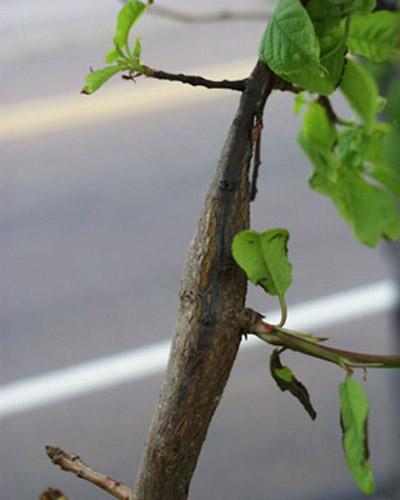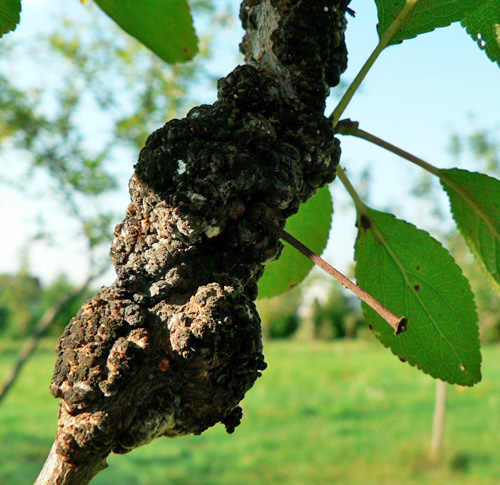Issue 10, June 26, 2009
Black Knot
The fungal disease, Black Knot (Apiosporina morbosa), affects about 25 Prunus species. The more susceptible species include edible and ornamental plums and cherries. Initial infections cause brown swellings or galls that are usually elongated on branches. A young gall is shown in the first image. Frequently the galls/knots are on one side of the twig allowing the gall to elongate and causing the twig to bend sideways. These galls are difficult to see when the trees are in leaf.

With time, the bark covering the gall surface splits revealing an olive green fungal stroma. The stroma hardens and blackens during the winter. Once the blackened knot has released ascospores, it dies. If the black knot has completely girdled the twig, the twig beyond the gall will die. As long as the twig is alive, the fungal growth continues to expand downward along the twig. If side branches are encountered, the fungus usually encompasses, girdles, and kills those branches as well as shown in the second image. It is common to see a white fungal parasite (Trichothecium roseum) growing on the knot by the end of the second growing season.

Black knot, Apiosporina morbosa, overwinters in live knots as stroma. Spring rains stimulate the release of the ascospores which are then carried by the wind. The ascospores can enter through wounds, such as pruning cuts, but they can also enter directly into green twig tissue during periods of free moisture (rains, heavy dews, irrigation, etc). Once the spores germinate, the fungus penetrates the protective cuticle. The fungus grows through the twig for several months before stimulating the swelling that is the gall/black knot. Numerous black knots occur in susceptible trees. Severely infected trees decline in vigor and yield. Death of the plant may also occur.
Researchers suspect that there are subspecies of the fungus that are host specific. This would explain why different susceptible Prunus plants growing close to each other react differently to the disease.
Disease management may involve pruning and using fungicides. Prune out the black knots during the winter when plants are dormant. Use lime-sulfur as a dormant application after pruning or use thiophanate-methyl four times through the year. Apply while the tree is in dormancy, when the flowers are at pink bud, at petal fall, and 3 weeks after petal fall. If the infection is severe, spraying for two consecutive years can help.
Black knot is discussed in Report on Plant Disease 809, Black Knot of Plums and Cherries. This University of Illinois publication is available free of charge.--Jim Schuster
Author:
Jim Schuster